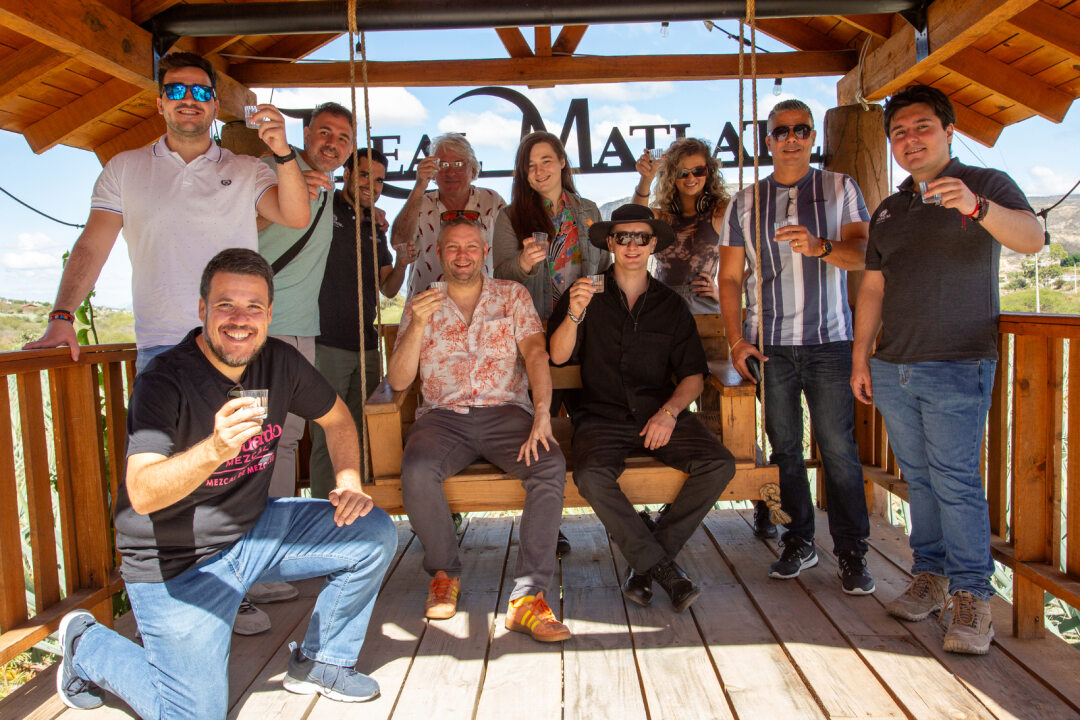A cramped, twelve seater bus trundles through the street-art-riddled roads of Oaxaca…
Inside, a bottle of mezcal exchanges hands like an adult game of pass the parcel. Broken speakers belt out classic Rock and Pop hits, completing the scene of sing-songing, drink-slinging new friends. A shared, joyous approach to new experiences held our enthusiasm, in spite of jetlag, lack of sleep and bellies full of Mezcal. Distilleries? Aztec ruins? A wood carving workshop that inspired Coco, or a simple local market? Adventure was constant and moments of rest were few and far between.
El Recuerdo means memory, or keepsake. An emotional journey began at the regional finals of the Recuerdo/Zignum cocktail competition at Verve in Leeds, and ended during Dias de los Muertos in Oaxaca. With my admittedly little writing experience, I’m going to try and describe the trip, provide a feel for the colour and flavor of Oaxaca, and perhaps lend some advice to future competitors.
Day of the Dead
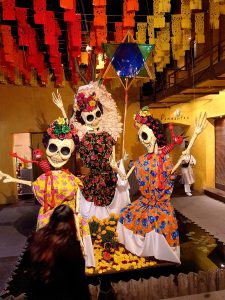
Brits are famously reserved when it comes to emotions, and it is indeed often frowned upon to discuss topics such as death, grief, depression or even happy memories relating to lost loved ones. When someone dies, the celebrations tend to start and end with the funeral, which, I hope it is not controversial to say, very rarely feels celebratory.
Mexico’s Day of the Dead tackles this reservation head on every year, when the dead are invited back to catch up with family. Families create intricate altars at home to invite their passed relatives back with open arms, and on the day itself, visit the graveyard to spend time with them. The time spent is far from morose, in fact, is rather a celebration of life – a party, almost. There is food, music, beer, mezcal and laughter in the candle lit labyrinth of Oaxacan cemeteries. I was lucky enough to get my face painted as well, honouring my loved ones while enjoying the party. I so desperately hope they were there with me…
On the second day of the festival, we visited the graveyard. One thing that shocked me was the truly joyous approach to the day; the music, lights and fantastic artistry surrounded such a place of sorrow. Beyond the cemetary, every shop, cafe, bar and restaurant decorated in bright flowers, art, sculptures and skeletons. The yearly dedication to providing a beautiful space for the dead to return is astounding.
If there is one thing I’ve brought home with me from Mexico, it’s a desire to spend more time with those I have lost and miss dearly.
A Culture of Art
Time moves slower in Mexico. At least, it feels that way. Folk seem to simply take their time with things in a way that feels almost meditative. Most agaves take over twelve years to reach maturity before they can even begin to be made into Mezcal. Black clay, a traditional Mexican form of pottery, takes three months per piece to complete, which doesn’t include a trip to the mines and mountains in order to acquire the clay in the first place. Waiting is almost a tradition in and of itself, and in my opinion, is the reason Mexico is home to some of the worlds best art. Every building, wall, street, floor, you-name-it is absolutely coated in rich, vibrant colour.
Perhaps most vibrant of all the arts, are the wood carved alebrijes. The wood used to carve the models takes three whole years to dry out, and locals forage for pigmented ingredients in order to create the unique paints. Alebrijes are a sort of guide, and each person has an animal that guides them through life – the protector – and one that guides them to the afterlife. I am protected by the snail, and guided by the iguana. Shout out to Slimon, my pet snail and Eliot, my pet lizard. Albeit, Eliot is a bearded dragon not an Iguana but don’t get caught up on the details.
Art is ingrained into the very walls of Mexico. Even the Matatlan mezcal distillery we visited sported an impressive art gallery. Speaking of…
Mezcal
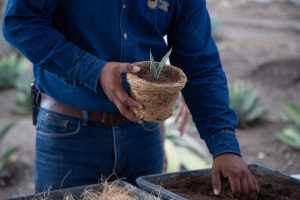
It is only proper that while I write this article, I do so with a small dram of Zignum mezcal, contentedly sipping with kisses while enjoying a YouTube playlist – “vintage jazz playing in another room and it’s raining”. What can I say? I’m a party animal. My mezcal, poured with a measure from the heart sitting in a traditional tea light candle holder. When a candle is finished, they are repurposed as Mezcal glasses, often with subtle engravings marked into the glass. In Oaxaca, everything is art.
Of the two distilleries we visited, the Matatlan Palanque was positively quaint. Greeted by a huge paper mache skeleton and sand sculpture, that formed not only the entrance way but a particularly intricate altar, the mood was immediately solidified. It was 10am. Mezcal time. Mezcal in hand (are you sensing a pattern?) and wonder in our hearts, we set out through the agave farm. Did you know Mezcal can be made with over fourty variety of agave?
Espadin is of course the most popular, but we were lucky enough to be presented with a range that panned multiple wild agaves, each with their own completely unique flavor profile. Mezcal production is nothing short of artisanal, with the years and years it takes to grow the plant, and twelve kilos of agave producing only one litre of mezcal. A uniquely sweet, ‘fermentey’ scent fills the air as we approached the fire pits, huge craters of volcanic rock, pine wood and dirt help to insulate and cook the agave for days. Apparently, a master mezcalero can ascertain the readiness of the agave by smell, climate and temperature.
There are no fancy tools here, just instinct and talent. Highlighting the end of this tour, I was lucky enough to try their mezcal straight from both french and american oak barrels. The french had a sweet, almost sherry-like quality, while the American oak more closely resembled more familiar spirits and flavour profiles. Both delighted the senses.
By comparison, the Casa Armando distillery, that produces El Recuerdo, Zignum and Senoria (not currently available in the UK) is epic in scale. Water fountains create ambient noise for the astounding mansion-like buildings that backdrop the endless agave farm. Casa Armando like to keep their distilling skills close to their chest, as one of the most cutting edge distilleries in Oaxaca. However one thing that struck me was their dedication to the preservation and renewal of wild agave, even though they don’t use it in their own Mezcal.
Once an agave plant grows enough to drop seeds, it is no longer good for Mezcal, which contributes to a rapid decline. Casa Armando cultivate and grow these seeds, which should ensure a future where these plants will thrive and, ultimately, create even more delicious Mezcal. Take a shot of Mezcal everytime I use the word Mezcal in this article, and you may get a feel for the amount that was consumed by the gang across the week in Oaxaca.
While at the Casa Armanda distillery, we partook in a small, friendly cocktail competition with ingredients sourced from a local market. I didn’t win this one, but spirits were high and fun was most certainly had. My recipe, if you’re interested:
2oz El Recuerdo Mezcal
0.75oz Lime Juice
0.5oz Paprika, honey and chilli syrup
0.5oz Grapefruit
0.25oz Pomegranate juice
Top Watermelon Soda
Rimmed with honey and chilli jam with sal de gusano (worm salt)
Coffee, Cocktails and Crickets
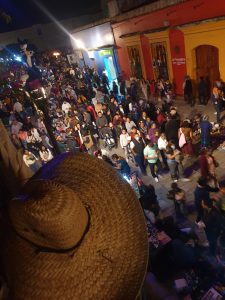
Those who follow Barlife may have seen my previous article, and therefore know that I have an immeasurable passion for great coffee. You can imagine my excitement upon visiting the worlds’ eighth largest grower and producer of coffee – it doesn’t get much fresher than it does in Oaxaca. I knew I was in for a treat when I visited ‘Cafeto & Baristas’ and read that the menu contained the exact brew time and temperature for its house cold brew, which just so happened to be the best I’d ever had. Fruity, tropical, perhaps a little herbal? So so smooth, no sugar required. However, I wasn’t there for coffee. Cocktails won me the competition after all…
Between England and Barcelona, three competitors had won their way to Oaxaca – myself, Louis, and James. We each had cocktail bars we desperately wanted to visit, and so we each picked one:
Louis – El Espacio – Tiny. Four tables. Short list of cocktails. I had a delightfully floral blend of Mezcal and chartreuse (yes they have it) with some local ingredients I’m still not sure how to pronounce and describe.
Myself – Selva – North American top 50 bar Selva did not disappoint, hidden inside a stunning labyrinthian building sporting an inner jungle of plant life and forna all before you’ve even reached the interior. I enjoyed a blend of Mezcal (shocking), coffee, tamarind and pitona which came together to create a truly unique sipping experience. Coffee is an underrated ingredient in cocktails, and, if using the correct specialty coffee has uses far beyond the simple espresso martini.
James – Handshake – It’s the final night, and we’re staying over in Mexico City to catch an early flight back to sunny England. Officially, the festivities are over. For me and James? The impossible to resist allure of Handshake, which sits comfortably at no. 3 in the world top 50 bars. Describing Handshake is difficult – as we made our way through the doors, we were greeted not only by the bartenders, but the entire room in an uproarious “salut”. The staff kindly gifted some hot towels to wash our hands and face, and it was immediately apparent the level of service that lands you such a spot on a global scale. Between the two of us, we sank about half the menu. Standout drinks included a fantastic blend of sherries, banana and rum with an edible Lego brick, as well as yet another coffee and mezcal drink, this time carbonated, sweeter with whey and toasted notes. Finally, the world famous fig and coconut negroni, which I simply have no words for. Simple, delicious, perfect.
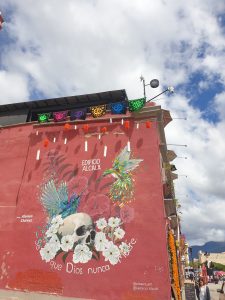
Beyond the cocktail bar, we were treated nightly to gastronomical experiences that celebrated the history of Mexico and Oaxaca. I’ll never experience tacos quite the same way again. During the week, I consumed crickets, grasshoppers, worms, and the spiciest food imaginable. When asked by the waiter about my allergies and intolerances, I didn’t think ‘ants’ were going to come up. Imagine my surprise when traditional Oaxacan pizza contained exactly that. Apparently the violent, hospital inducing rashes I can get from living ants don’t translate to cooked ones. Who knew?
You have to try everything though, right? Life is short, food is delicious and you won’t remember the things you didn’t try. If you’ve made it this far, please understand that this is about as brief a summary of the trip as I could write, and that my penmanship only provides an outline of the beauty of Oaxaca. Ultimately, the trip was made by the people. It really was the friends we made along the way. Instead of trying to find a profound note to end this article on, I’d instead like to thank Luis, Oscar, Marcela, Juan, Elisha, James, Louis, David, Neil and Victor for being the perfect traveling companions, and an extra special thanks to Mario for taking such beautiful pictures and lending them for this article. I’ll carry this journey with me for the rest of my life.
Advice for Future Competitors
Follow the brief. Make sure your drink is replicable. You want to make a drink that’s going to be sold everywhere? Well it better use ingredients that are available everywhere, and GP considerate. Beyond that, work on your performance, give the judges something to latch onto.
Be memorable…


